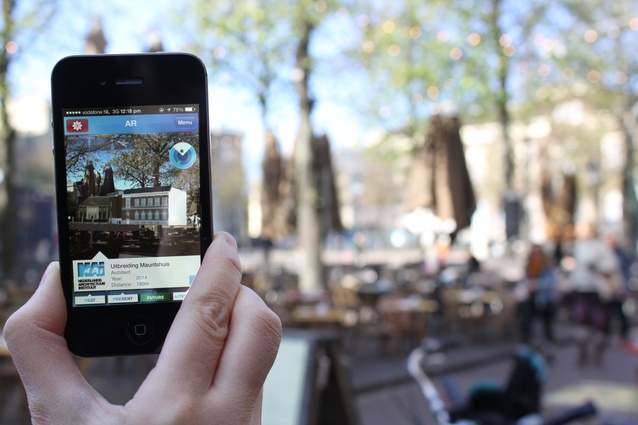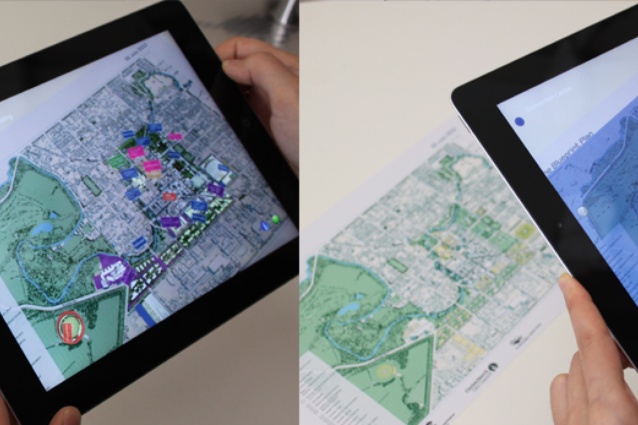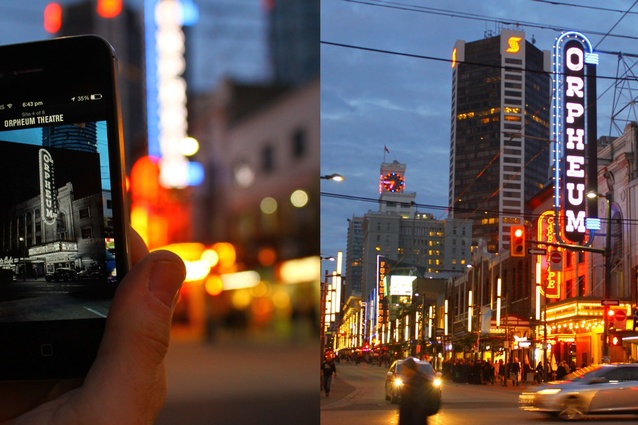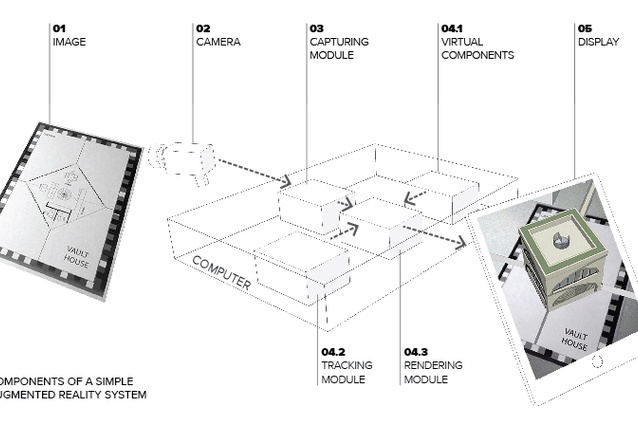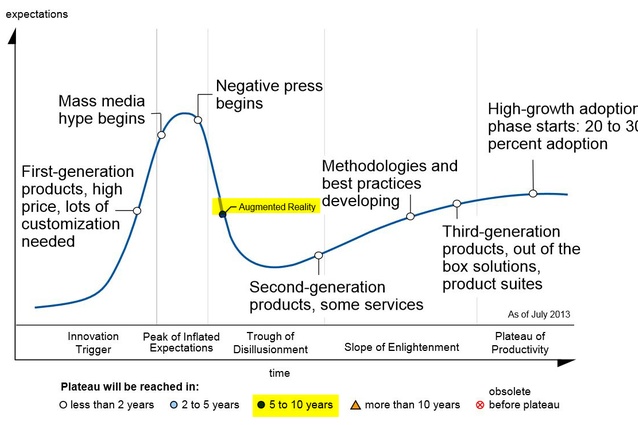Architecture in an age of Augmented Reality
Sydney architect Rana Abboud won a NAWIC Scholarship in 2013 to investigate the opportunities and obstacles for Augmented Reality in the practice of architecture. She reports for ArchitectureAU on her key research findings.
Augmented Reality’s potential for Architecture is huge. “AR” is any system that overlays, or ‘augments,’ the real world with digital information that seemingly co-exists. Today’s AR applications hint at a future to come: virtual furniture may be overlaid in real time to check its size and appearance in a room; ‘see-through’ walls on a construction site allow builders to view pipes and mechanical ducting behind; and overlays of past and future buildings render the city a canvas for virtual data. As tech giants race to release wearable interfaces for ever greater augmentation of the physical world, the number of worldwide users consuming AR via portable media devices is expected to exceed 1 billion users by 2020.
As recipient of the 2013 International Women’s Day Scholarship awarded by the National Association of Women in Construction (NAWIC), I recently researched the Opportunities and Obstacles for Augmented Reality across key phases of architectural practice. My focus was on a subset of AR known as Mobile Augmented Reality (MAR), which applies the concept of AR in truly mobile settings, away from special-purpose work areas.
With MAR, displays are portable, and range from smartphones, to tablets, to wearable Head-Mounted Displays (HMDs). My intent was to identify high-level uses for Mobile AR across key architectural phases, and explain the challenges currently preventing MAR’s uptake by the Australian architecture profession. My focus question was: “What are the opportunities and obstacles for mobile AR in key phases of architectural practice – namely, design, construction, and post-completion?”
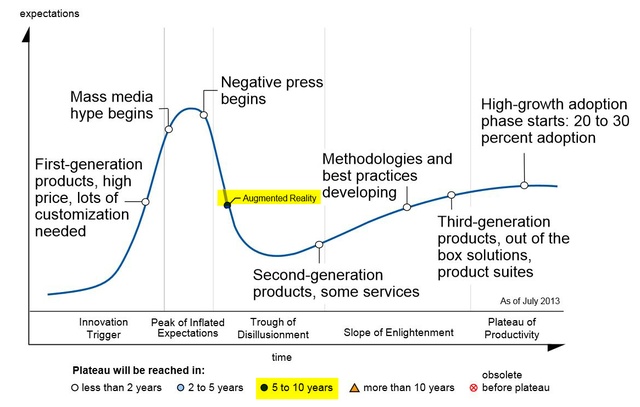
The AR trail took me on a study tour across North America, Europe, and Oceania. With the support of NAWIC and Architectus, I met with AEC industry leaders, AR developers, software researchers, academics, and pioneers of AR in construction applications worldwide. I discovered that Augmented Reality had reached the pinnacle of news media hype in 2011, and that its users were now hurtling towards the ‘Trough of Disillusionment.’ I tried on Head-Mounted Displays, and found out the Google Glass was not true AR. I also uncovered a broad spectrum of Use Cases and AR prototypes relevant to architecture.
Opportunities: Design
AR can overlay a real site with a virtual design at full-scale. A growing number of AR developers and visualisation providers now offer AR platforms that enable ‘walking tours’ of a virtual building, from early design through to construction. Those from backgrounds outside the construction industry often struggle to decode technical planning documents, or interpret 2-D drawings to understand their 3-D implications. MAR applications promise to bypass such ‘coding’ and ‘translation’ models of spatial communication, and more intuitively convey the intended appearance, scale, and features of a proposed design.
AR platforms can also isolate individual elements within a spatial scheme for presentation at full scale. By using virtual components to stand in for physical objects, AR can save on the fabrication and material costs of real-world prototypes. Such applications are useful in clash detection, to visually detect overlaps between proposed virtual content and real world elements. Today’s commercial applications in this area are limited to mass-manufactured objects, whose modular nature provides a compelling business case for AR platforms that communicate scale.
MAR platforms can also augment physical models and drawings with unlimited virtual content. The most common augmentation of presentation media today is when a paper drawing, such as a 2D plan, becomes the marker for a 3D model overlay. But the value-add of AR is in communicating information that other media cannot, such as 4D content (information with a time component). Overlays need not be limited to visual applications either, as AR can draw on other senses to communicate elements of a scheme, such as the acoustics within a space.
But while the most familiar uses in design today are in design visualisation, (such as with the Augmented Australia 1914-2014 exhibition planned for Venice), AR will increasingly inform the design process itself. With AR, multiple users may share the same physical space and perceive the ‘spatial presence’ of a digital object, making it an ideal medium for collaborative problem solving. MAR applications promise to bring the designer into more direct contact with the building site, allowing building designers to quickly contextualise and review their designs in situ.
Opportunities: Construction
Great potential for AR lies in construction phase applications, where AR platforms can geo-locate BIM data directly on the construction site. BIM data overlaid in AR view onto the construction site has three main uses:
- to visualise what is not yet built (the future);
- to view what is hidden (buried elements, or elements obstructed from view); and
- to see what cannot be seen (alignment information, easements, site boundaries, or environmental events - such as a 1-in-100-year flood level).
Overlaying BIM data onto what is actually in place may benefit professionals undertaking site inspections, and contractors checking construction progress. AR may be used to confirm precise installation locations for construction components; locate materials, equipment and safety zones on a project site; and locate construction and project component details for more efficient communication of this data to site workers.
MAR platforms may also provide 3-dimensionally registered instructions onto physical components to provide task support for assembly processes.
Boeing spear-headed the first AR application in an industrial assembly process in the early 1990s. But while the aviation, astronautics and automotive industries have explored AR extensively for task support, the construction sector has lagged behind.
This is largely due to the one-off nature of most construction projects, and the multiple processes involved in procuring a custom building. With their repetitive manufacturing processes, prefabricated buildings are ideally suited for AR-based task support.
Opportunities: Post-completion
Once a building achieves practical completion, visual and auditory AR overlays may guide users through complex maintenance and repair tasks on its component systems. Buildings with highly specialised parts, or with numerous modular elements, are candidates for MAR apps that aid in maintenance or repair.
This is especially true where the cost of developing a custom app may be offset by savings in the on-going future training of building operators. By directly overlaying real-time computer graphics onto actual equipment, AR can guide persons with little or no prior training through maintenance and repair tasks on complex equipment.
For on-going Facilities Management, AR systems may identify building elements and call up relevant information about these components in-situ. Today’s AR platforms for facilities management allow users to directly comment on building elements as metadata overlays to the physical world, and feed this commentary directly into the Building Information Model.
Obstacles
Despite many proof-of-concept prototypes that demonstrate AR’s possibilities, existing obstacles prevent AR from reaching a wider audience in AEC industries today. These obstacles encompass technological challenges, human factors and financial constraints.
One key technological challenge facing AR developers for AEC applications today is achieving stable ‘tracking’. Augmented Reality requires that computer-generated virtual objects remain ‘locked’ to the 3D locations and orientations of real world objects. ‘Tracking’ is the act of continuously identifying the position and orientation of an observer’s viewpoint with respect to a 3-dimensional reference system.
Tracking systems in construction and post-completion applications are required to cover a large range on site while maintaining high accuracy, often to within a few millimetres. On building sites with multiple storeys, tracking must also identify the relative level of a user, and relate this to the appropriate location within a virtual model. Today’s tracking systems do not yet satisfy the complex demands of chaotic outdoor construction sites, nor achieve the high accuracy required for precision applications.
The majority of outdoor AR use cases today rely on GPS for tracking. But GPS is accurate to within metres only; suffers from fluctuations in signal due to weather changes or signal blocking by neighbouring structures; and struggles to get a satellite fix indoors. Indoor tracking is often achieved with physical markers. But markers can deform with time and be obscured by building works. They are also sensitive to changes in ambient light, and have limited tracking range. Sophisticated hybrid tracking systems currently under development will be key enablers for AR in applications calling for high-accuracy.
The many challenges facing AR’s adoption explain why ICT research and consulting company Gartner predicts short-term frustration for professional users of this technology. Gartner publishes annual Hype Cycles for emerging technologies, to separate the hype surrounding a technology from reality.
In July 2013, Gartner placed AR on a downward trajectory towards the aptly named ‘Trough of Disillusionment’ after having reached the ‘Peak of Inflated Expectations’ in 2011.
Given the exaggeration of AR’s abilities in today’s news media, early adopters of MAR risk disillusionment when prototypes are not stable enough for commercial application. Rather than await the development of new methodologies and products, some users may write AR off entirely, and continue with ‘tried and true’ workflows. Yet those who persist and work through MAR’s hurdles will likely reap benefits in 5-10 years’ time, when the technology reaches Gartner’s predicted ‘Plateau of Productivity’. I, for one, look forward to the ‘Slope of Enlightenment’ towards that Plateau.
Read Rana Abboud’s full research paper, Architecture in an Age of Augmented Reality: Mobile AR’s Opportunities and Obstacles in Design, Construction, and Post-Completion, here.

